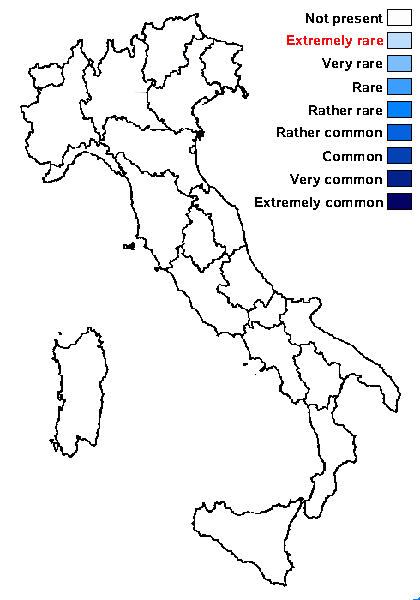Bacidina caligans (Nyl.) Llop & Hladun
Fl. Liquenol. Ibérica, 3: 109, 2002. Basionym: Lecidea caligans Nyl. - Flora, 57: 10, 1874
Synonyms: Bacidia caligans (Nyl.) A.L. Sm.; Woessia caligans (Nyl.) Sérus. & Diederich
Distribution:
Description: Thallus crustose, thinly episubstratic, dull green, grey or pale brown, with granulose, soredia-like, 20-50 μm wide goniocysts which are often gathered in rather discrete, orbicular, soralia-like aggregates. Apothecia biatorine, 0.2-0.6(-1) mm across, with a flat to irregularly convex, red-brown to brown-black disc, and a usually darker, finally often excluded proper margin. Proper exciple red-brown and K+ purple in outer edge, colourless within, the cell lumina up to 7 μm in diam. towards the edge and in lower part; epithecium poorly differentiated, colourless or pale purple-brown, the pigmented parts K+ intensifying purple; hymenium colourless to very pale brown, 45-55 μm high; paraphyses mostly simple, 1-2 μm thick at base, the apical cells up to 5 μm wide; hypothecium colourless. Asci 8-spored, clavate to cylindrical-clavate, the apical dome K/I+ dark blue with a pale, conical-pointed apical cushion (axial mass) never penetrating through the entire d-layer, the wall K/I-, but the thin outer gel K/I+ blue, Bacidia-type. Ascospores 3-7-septate, hyaline, acicular, 24-48(-63) x 1.5-2(–2.5) μm. Pycnidia immersed, white or pink-brown around the ostiole. Conidia thread-like, curved, 29-35(-45) x c. 1 μm. Photobiont chlorococcoid. Spot tests: thallus K-, C-, KC-, P-, UV-. Chemistry: thallus without lichen substances, apothecia with the Laurocerasi-brown pigment, concentrated in the uppermost, outer part of the proper exciple, but sometimes diffusely present also in the hymenium.Note: According to Ekman (2023), the epithet caligans has been extensively misused for morphs of the primarily corticolous Bacidina adastra, B. assulata and B. neosquamulosa with pigmented apothecia. The species is relatively rare, occurring on acidic to moderately basic rock, decaying bryophytes or lignum, exclusively on metal-enriched substrata. To be looked for in Italy.
Growth form: Crustose
Substrata: rocks and lignum
Photobiont: green algae other than Trentepohlia
Reproductive strategy: mainly asexual, by soredia, or soredia-like structures (e.g. blastidia)
Species of metal-rich rocks

Predictive model
Growth form: Crustose
Substrata: rocks and lignum
Photobiont: green algae other than Trentepohlia
Reproductive strategy: mainly asexual, by soredia, or soredia-like structures (e.g. blastidia)
Species of metal-rich rocks

Predictive model
 Index Fungorum
Index Fungorum
 GBIF
GBIF


